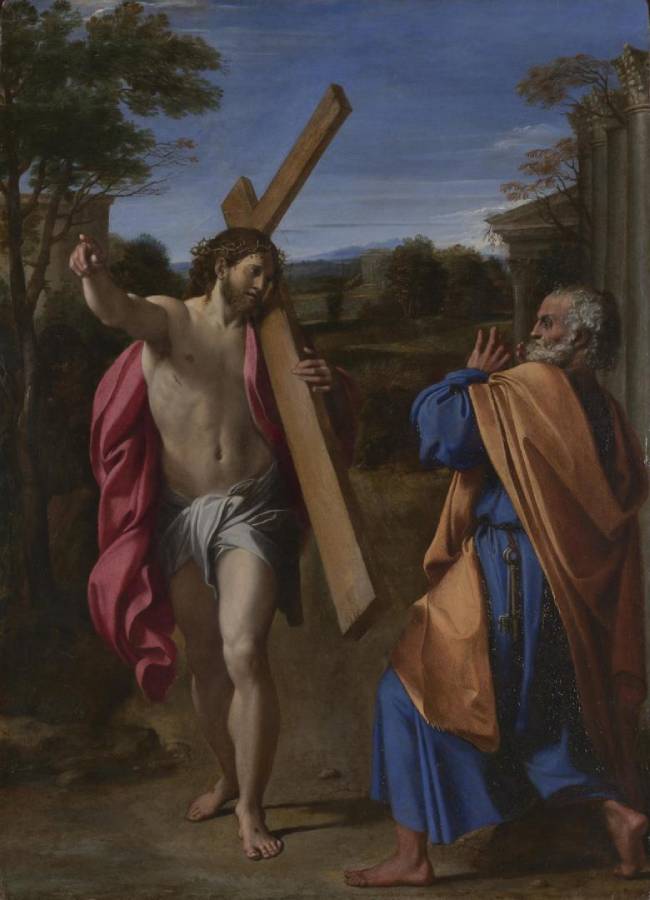Carracci, Annibale (1560-1609)
Domine, quo vadis? (Christ appearing to Saint Peter on the Appian Way)
1601–1602
Oil on wood, 77.4 x 56.3 cm
National Gallery, London
Saint Peter fled Rome after Christ’s crucifixion, scared that he too would be executed by the Romans; here, he stands in shock as Christ passes him on the road. When the saint asked Christ where he was going – the question in this painting’s title – he replied that he was headed to Rome to be crucified again. Shamed, Peter turned back to face his own martyrdom, but asked to be crucified upside down so as to avoid comparison with Christ.
The subject is not a very common one, and this painting was almost certainly commissioned by or for Cardinal Pietro Aldobrandini, whose name-saint was Peter. Certainly it was in his collection by 1603. Aldobrandini was nephew to Pope Clement VIII, and one of the greatest patrons in early sixteenth-century Rome (he also commissioned The Vision of Saint Jerome and the Villa Aldobrandini frescoes). The Cardinal had been deeply impressed by Annibale’s work on the Farnese Gallery – for which see the Farnese Gallery cartoons – and his personal secretary, Giovanni Battista Agucchi, knew Annibale well and may have been instrumental in the commission of this painting
Annibale had done a preparatory study (now in the Albertina, Vienna) for a version of the subject by his pupil Taconi, painted on the vaulted ceiling of the Cerasi Chapel in Santa Maria del Popolo, Rome in 1600–01. In the drawing, Christ is fully clothed and Saint Peter kneeling. Annibale radically revised the design in this picture, rotating it to fit an upright panel, which had a dramatic effect on the composition. Christ, now nearly nude, strides vigorously towards us, pointing emphatically into our space. He turns his head to gaze at Saint Peter, who throws up his hands in astonishment.
The vertical lines of the trees and classical buildings on either side press the two figures closer together, intensifying the emotion of the glance they exchange. Annibale made changes during the course of painting, particularly to the figure of Peter. X-rays show that Peter was first depicted in profile, standing, but much closer to Christ. This was obviously felt to be too static and lacking in emotion, so the whole pose (except for the left foot) was changed, so that he now recoils dramatically from his startling vision.
The draperies, in primary colours of red, blue and yellow, glow against the cool greens and greys of the calm, classical landscape, which recedes into the distance. Daylight dawns above Saint Peter’s head, underlining his visionary realisation that he must accept his own sacrifice.
In spite of the painting’s relatively small dimensions – it is less than a metre tall and around half a metre wide – its effect is highly monumental. The sculptural forms are typical of Annibale’s late style – Christ’s muscular torso barely shows any signs of his suffering during the Passion – and clearly reveals the artist’s study of Michelangelo, notably his sculpture of the Risen Christ in the church of Santa Maria sopra Minerva, Rome, and of Raphael’s tapestry cartoons, specifically The Charge of Peter (Victoria and Albert Museum, London). (NG)
